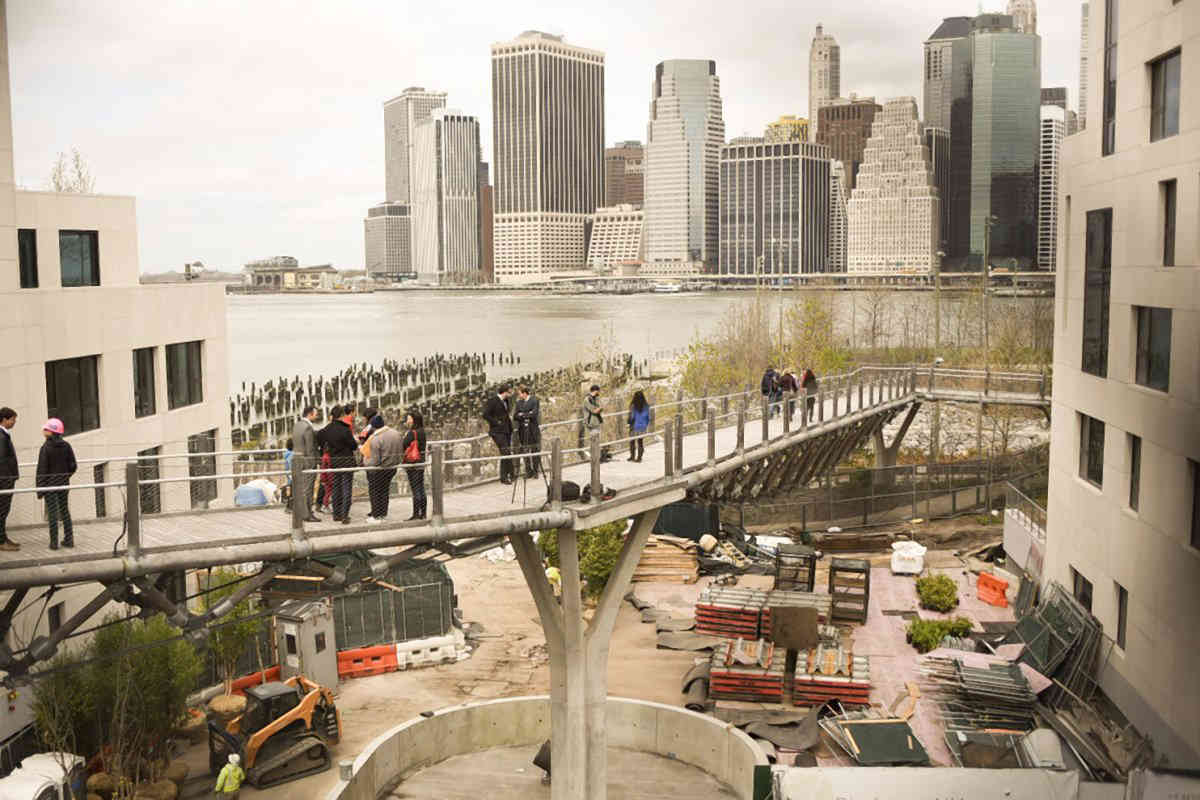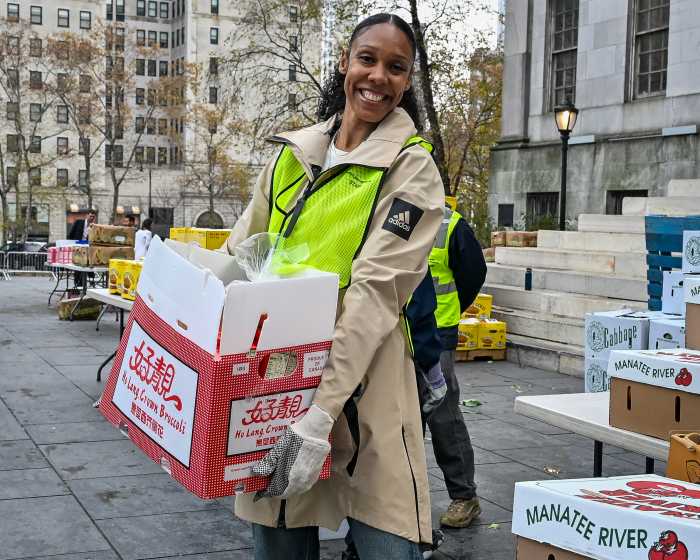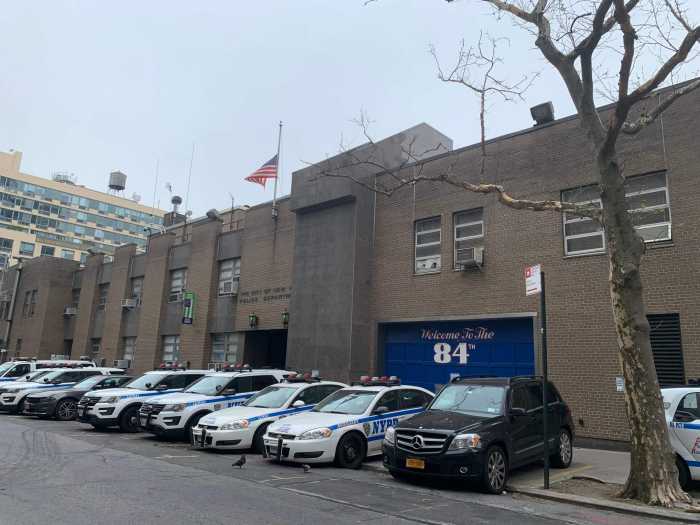Wood you look at that?
The sustainable and long-lasting black-locust wood used to construct the soon-to-be-demolished Squibb Bridge to Brooklyn Bridge Park is not to blame for the span’s structural failures, despite meadow stewards’ claims, according to a wood expert who supplies the timber for projects across the country.
“It’s really not the wood’s fault at all,” said Zach Rike, the founder of North Carolina–based supplier Robi Decking, and a self-described 40-year veteran of the business. “It is easy for everyone to blame an inanimate object, but nothing could be further from the truth. The wood is not to blame.”
Bigwigs at the semi-private Brooklyn Bridge Park Corporation in July closed the Squibb Bridge, which zig-zags between its namesake Squibb Park and the waterfront lawn, for the second time since it opened in 2013, claiming a single faulty piece of black locust endangered locals walking across the span. Months later, green-space keepers in September announced the bridge would be shuttered indefinitely because a “higher than expected moisture level” caused more than just one of its planks to decay.
“Sadly, that one piece that showed visual signs of problems is not the only piece where we have deterioration,” said Brooklyn Bridge Park Corporation President Eric Landau, president of the semi-private Brooklyn Bridge Park Corporation.
And last December, meadow stewards revealed they would spend millions to replace the bridge originally funded by taxpayer dollars, and construct a new steel-and-aluminum span in its place.
But Rike — who supplied the black locust used to build the roof deck at the Brooklyn Children’s Museum, and other still-standing projects across the city and country — challenged Landau’s claim that the timber, which is known for its ability to withstand the harshest of elements, simply rotted.
The expert argued that any deterioration found in the wood was instead the fault of the bridge’s designers, who he said didn’t account for how the timber reacts to changes in climate, and too tightly fastened the metal connectors at the end of each plank, resulting in the deterioration.
“The issue with the bridge was the design, and specifically the connectors used. These connectors did not allow for the wood to expand and contract with moisture changes, and when the wood had nowhere to expand, it caused tension, and the wood fibers to press against each other,” Rike said. “The wood did not rot. It’s woodworking 101.”
Rike compared the need for space between wood and connector to the need for space between a finger and a ring. When it’s cold out, a finger may contract, but when it’s hot, that finger will likely expand — and without space to accommodate that growth, a ring on that finger could quickly cause problems, he said.
“Now imagine that the finger is a big piece of wood, and the ring an airtight metal clamp. Imagine what happens when that wood-finger gets humid and expands, with no soft skin and blood to brace the impact,” he said. “This is what happened to the bridge, and the engineers and contractors should have known this.”
Rike followed the story of the $4-million, taxpayer-funded Squibb Bridge for years, he said, from its highly anticipated opening, to its 2014 closure and subsequent $3-million repair, to its 2017 reopening, to its second closure last year. And he concluded that the wood itself isn’t to blame for the recent problems after studying pictures of the span, and consulting with other engineers also familiar with black locust.
“From all the pictures I have seen, I think the support structure of the wood is the issue, and that’s what causing the structural problems,” he said. “Where the wood is deteriorating, it’s simply caused by the design of the bridge. It’s really simple stuff.”
Indeed, even Landau admitted how unusual it is for black locust to rot months before he announced the Squibb Bridge would face the wrecking ball.
“Every wood expert we spoke to said black locust is the best there is — you could put it into a vat of water for 100 years and you’d never have deterioration,” the park-keeper-in-chief said back in September. “So we were really surprised, as was our wood expert, when they discovered that we had a piece with decay.”
And the beleaguered bridge’s too-tight connectors aren’t its only engineering flaw — its architects did not let the black-locust planks dry long enough to develop healthy cracks before putting them to use, according to Rike.
“The wood did not air dry long enough. We think that because, based on the pictures, there was no cracking of the wood,” he said.
The expert is so confident of the wood’s integrity that he shared his hypothesis with Brooklyn Bridge Park leaders, telling them he’d take the planks off their hands. But he has yet to receive an answer to his offer, he said.
“We’ve been in touch with them to tell them, they haven’t responded. We’d also like to buy the wood and reuse it,” Rike said. “We can still utilize that wood.”
Rike — who unsolicitedly contacted this newspaper, and was not involved in designing, building, or repairing the Squibb Bridge — claimed he did so to set the record straight about black-locust wood, which he admitted is a popular material used by his for-profit company.
“The only motive I have is to make sure that black locust doesn’t get a bad name,” he said. “We did not supply the black locust wood, but we do have a black-locust wood company and want to make sure the true story gets out on this.”
Brooklyn Bridge Park leaders — who plan to shell out $6.5 million for the Squibb Bridge’s replacement span — denied Rike’s claims, but refused to share the engineering report that led them to indefinitely shutter the bridge in September, instead suggesting this reporter file a Freedom of Information Law request to obtain the document.
























